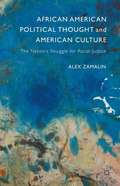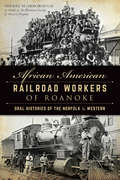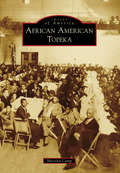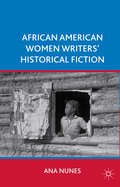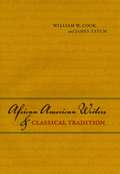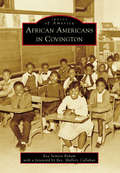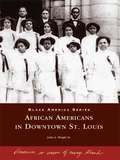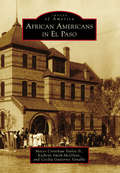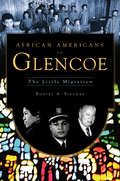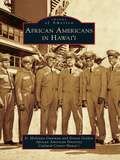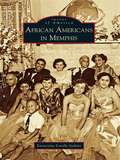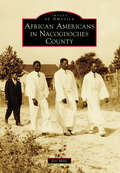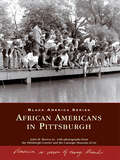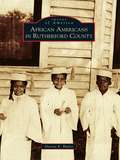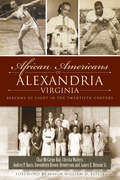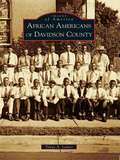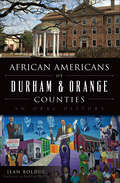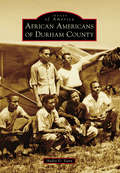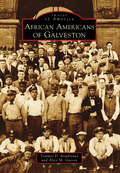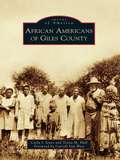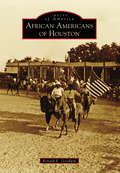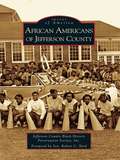- Table View
- List View
African American Literature: Voices in a Tradition
by Holt Winston RinehartAfrican American Literature Anthology for High School students
African American Political Thought and American Culture: The Nation's Struggle For Racial Justice
by Alex ZamalinThis book demonstrates how certain African American writers radically re-envisioned core American ideals in order to make them serviceable for racial justice. Each writer's unprecedented reconstruction of key American values has the potential to energize American citizenship today.
African American Railroad Workers of Roanoke: Oral Histories of the Norfolk & Western (American Heritage)
by Historical Society of Western Virginia Sheree ScarboroughRoanoke, Virginia, is one of America's great historic railroad centers. The Norfolk & Western Railway Company, now the Norfolk Southern Corporation, has been in Roanoke for over a century. Since the company has employed many of the city's African Americans, the two histories are intertwined. The lives of Roanoke's black railroad workers span the generations from Jim Crow segregation to the civil rights era to today's diverse corporate workforce. Older generations toiled through labor-intensive jobs such as janitors and track laborers, paving the way for younger African Americans to become engineers, conductors and executives. Join author Sheree Scarborough as she interviews Roanoke's African American railroad workers and chronicles stories that are a powerful testament of personal adversity, struggle and triumph on the rail.
African American Topeka (Images of America)
by Sherrita CampAfrican Americans arrived in Topeka right before and after the Civil War and again in large numbers during the Exodus Movement of 1879 and Great Migration of 1910. They came in protest of the treatment they received in the South. The history of dissent lived on in Topeka, as it became the home to court cases protesting discrimination of all kinds. African Americans came to the city determined that education would provide them a better life. Black educators fostered a sense of duty toward schooling, and in 1954 Topeka became a landmark for African Americans across the country with the Brown vs. Topeka Board of Education case. Blacks from every walk of life found refuge in Kansas and, especially, Topeka. The images in African American Topeka have been selected to give the reader a glimpse into the heritage of black life in the community. The richness of the culture and values of this Midwestern city are a little-known secret just waiting to be exhibited.
African American Women Playwrights: A Research Guide (Critical Studies in Black Life and Culture #31)
by Christy GavinFirst Published in 1999. Routledge is an imprint of Taylor & Francis, an informa company.
African American Women Writers’ Historical Fiction
by Ana NunesThis volume explores African American historical fiction written by women in the last four decades of the twentieth century. Nunes' approach to the texts aims at emphasizing the narrative and thematic achievements of individual novels set in the context of the main trends and developments of the contemporary African American historical novel.
African American Writers & Classical Tradition
by James Tatum William W. CookConstraints on freedom, education, and individual dignity have always been fundamental in determining who is able to write, when, and where. Considering the singular experience of the African American writer, William W. Cook and James Tatum here argue that African American literature did not develop apart from canonical Western literary traditions but instead grew out of those literatures, even as it adapted and transformed the cultural traditions and religions of Africa and the African diaspora along the way.Tracing the interaction between African American writers and the literatures of ancient Greece and Rome, from the time of slavery and its aftermath to the civil rights era and on into the present, the authors offer a sustained and lively discussion of the life and work of Phillis Wheatley, Frederick Douglass, Ralph Ellison, and Rita Dove, among other highly acclaimed poets, novelists, and scholars. Assembling this brilliant and diverse group of African American writers at a moment when our understanding of classical literature is ripe for change, the authors paint an unforgettable portrait of our own reception of “classic” writing, especially as it was inflected by American racial politics.
African Americans and Jungian Psychology: Leaving the Shadows
by Fanny BrewsterAfrican Americans and Jungian Psychology: Leaving the Shadows explores the little-known racial relationship between the African diaspora and C.G. Jung’s analytical psychology. In this unique book, Fanny Brewster explores the culture of Jungian psychology in America and its often-difficult relationship with race and racism. Beginning with an examination of how Jungian psychology initially failed to engage African Americans, and continuing to the modern use of the Shadow in language and imagery, Brewster creates space for a much broader discussion regarding race and racism in America. Using Jung’s own words, Brewster establishes a timeline of Jungian perspectives on African Americans from the past to the present. She explores the European roots of analytical psychology and its racial biases, as well as the impact this has on contemporary society. The book also expands our understanding of the negative impact of racism in American psychology, beginning a dialogue and proposing how we might change our thinking and behaviors to create a twenty-first-century Jungian psychology that recognizes an American multicultural psyche and a positive African American culture.African Americans and Jungian Psychology: Leaving the Shadows explores the positive contributions of African culture to Jung’s theories and will be essential reading for analytical psychologists, academics and students of Jungian and post-Jungian studies, African American studies, and American studies.
African Americans in Covington (Images of America)
by Rev Mallery Callahan Eva Semien BahamCovington is the seat of St. Tammany Parish government and sits north of Lake Pontchartrain in the New Orleans metropolitan area. Records from 1727 show 11 Africans on the north shore. One person of African descent was present at the founding of Covington on July 4, 1813. Most African Americans in antebellum Covington were slaves, with a modest number of free people, all of whom covered nearly every occupation needed for the development and sustenance of a heavily forested region. For more than 200 years in Covington, African Americans transformed their second-class status by grounding themselves in shared religious and social values. They organized churches, schools, civic organizations, benevolent societies, athletic associations, and businesses to address their needs and to celebrate their joys.
African Americans in Downtown St. Louis (Black America Series)
by John A. Wright Sr.Since the founding of St. Louis in 1764, Downtown St. Louis has been a center of black cultural, economic, political, and legal achievements that have shaped not only the city of St. Louis, but the nation as well. From James Beckworth, one of the founders of Denver, Colorado, to Elizabeth Keckley, Mary Todd Lincoln's seamstress and author of the only behind-the-scenes account of Lincoln's White House years, black residents of Downtown St. Louis have made an indelible mark in American history. From the monumental Dred Scott case to entertainers such as Josephine Baker, Downtown St. Louis has been home to many unforgettable faces, places, and events that have shaped and strengthened the American experience for all.
African Americans in El Paso (Images of America)
by Kathryn Smith-Mcglynn Maceo Crenshaw Dailey Jr. Cecilia Gutierrez VenableEl Paso's African American community can trace its origins back to the 16th century, when the black Moor known as Esteban roamed the southwest and, more significantly, those Africans in the party of conquistador Juan de Oñate crossed the Rio Grande in 1598. The modern El Paso African American community began to take shape in the 1880s, as the railroad industry, military establishment, and agricultural community all had black Americans in their ranks. Black leaders and their followers established a school and founded several significant black churches. Texas's first state branch of the National Association for the Advancement of Colored People is recorded to have been formed in El Paso; the first major court cases that challenged the all-white Democratic primary came from this city; the Texas Western College basketball team won the NCAA championship in 1966 with five starting black players; and today, the city is inhabited by black military retirees, entrepreneurs, educators, and other professionals (each with vibrant and socially conscious organizations), making it a progressive model of community development.
African Americans in Glencoe: The Little Migration (American Heritage)
by Robert A. SidemanThe village of Glencoe has a proud history of early African American settlement. In recent years, however, this once thriving African American community has begunto disperse. Robert Sideman, a thirty-year Glencoe resident, relates this North Shore suburb's African American history through fond remembrances of Glencoe communitiessuch as the St. Paul AME Church, as well as recounting the lives of prominent African Americans. At the same time, Sideman poses a difficult question: how can the village maintainits diverse heritage throughout changing times? African Americans in Glencoe reveals an uplifting history while challenging residents to embrace a past in danger of being lost.
African Americans in Hawai'i (Images of America)
by D. Molentia Guttman African American Diversity Cultural Center Hawai'i Ernest GoldenDuring the early 1800s, about two dozen men of African descent lived in Hawai'i. The most noteworthy was Anthony D. Allen, a businessman who had traveled around the world before making Hawai'i his home and starting a family there in 1810. The 25th Black Infantry Regiment, also known as the Buffalo Soldiers, arrived in Honolulu at the Schofield Barracks in 1913. They built an 18-mile trail to the summit of Mauna Loa, the world's largest shield volcano, and constructed a cabin there for research scientists. After World War II, the black population of Hawai'i increased dramatically as military families moved permanently to the island. Hawai'i has a diverse population, and today about 35,000 residents, approximately three percent, claim African ancestry.
African Americans in Memphis (Images of America)
by Earnestine Lovelle JenkinsMemphis has been an important city for African Americans in the South since the Civil War. They migrated from within Tennessee and from surrounding states to the urban crossroads in large numbers after emancipation, seeking freedom from the oppressive race relations of the rural South. Images of America: African Americans in Memphis chronicles this regional experience from the 19th century to the 1950s. Historic black Memphians were railroad men, bricklayers, chauffeurs, dressmakers, headwaiters, and beauticians, as well as businessmen, teachers, principals, barbers, preachers, musicians, nurses, doctors, Republican leaders, and Pullman car porters. During the Jim Crow era, they established social, political, economic, and educational institutions that sustained their communities in one of the most rigidly segregated cities in America. The dynamic growth and change of the post-World War II South set the stage for a new, authentic, black urban culture defined by Memphis gospel, blues, and rhythm and blues music; black radio; black newspapers; and religious pageants.
African Americans in Nacogdoches County (Images of America)
by Jeri MillsTypical of most communities after the Civil War, Nacogdoches's African Americans had to repurpose their lives by building their own communities while they carved a life of survival first and progress second. The images in this book will tell the stories of the first churches and how they became the center of the community. Other images will share information about the early leaders in the community who helped establish educational facilities for "Negroes." Additional images focus on black businesses, and a final set of images will discuss the emerging black middle class and others who played significant roles in Nacogdoches history. Readers of this book will go on a journey, through images, that highlights residents' pains of struggles and gains of triumph.
African Americans in Pittsburgh (Black America Series)
by Carnegie Museum of Art Pittsburgh Courier John M. Brewer Jr.African Americans in Pittsburgh chronicles the distinct trends in this African American community. There was never one centralized neighborhood where a majority of the black population lived, and city schools were integrated until after desegregation laws were passed. Photographs captured by famed Pittsburgh photographer Charles "Teenie" Harris show the candid experiences of residents, including the achievements and celebrations of people struggling to put scraps of food on the table.
African Americans in Rutherford County (Images of America)
by Devora E. ButlerAfrican Americans have heavily contributed to and shaped the unique and vibrant Rutherford County in middle Tennessee. Located 30 miles southeast of Nashville, Rutherford County is at the state's geographical center. This area is home to the Stones River National Battlefield, a national park that was the site of a major Civil War battle--the Battle of Stones River. Tourists come from all over the world to experience this rich cultural and historic venue that once served, although briefly, as the capital of Tennessee. African American men and women have lived, worked, and toiled here for generations.
African Americans of Alexandria, Virginia: Beacons of Light in the Twentieth Century (American Heritage)
by Christa Watters James E. Henson Sr. Audrey P. Davis Gwendolyn Brown-Henderson Char McCargo BahSitting just south of the nation's capital, Alexandria has a long and storied history." "Still, little is known of Alexandria's twentieth-century African American community. Experience the harrowing narratives of trials and triumph as Alexandria's African Americans helped to shape not only their hometown but also the world around them. Rutherford Adkins became one of the first black fighter pilots as a Tuskegee Airman. Samuel Tucker, a twenty-six-year-old lawyer, organized and fought for Alexandria to share its wealth of knowledge with the African American community by opening its libraries to all colors and creeds. Discover a vibrant past that, through this record, will be remembered forever as Alexandria's beacon of hope and light.
African Americans of Davidson County (Images of America)
by Tonya A. LanierAfrican Americans were present in Davidson County long before it was officially formed from Rowan County in 1822. The exact time or place of settlement remains in question. They served not only in the stereotypical roles of farm laborers and house slaves but also as skilled traders, blacksmiths, furniture makers, and artisans. From Petersville, Southmont, Thomasville, Midway, Lexington, Belltown, Reeds, Churchland, and tiny areas in between, great men and women found a sense of stability. They made a life out of the scraps that were left behind. This collection of historical photographs is a textured look at African Americans in Davidson County. Images of community notables like A. B. Bingham, Charles England, Rev. A. T. Evans, and Etta Michael White and iconic structures like St. Stephen United Methodist Church, Dunbar High School, and the Hut, these photographs weave together stories that outline the African American journey.
African Americans of Durham & Orange Counties: An Oral History (American Heritage)
by Jean BolducDurham and Orange Counties have vibrant and active African American communities. Throughout the region's unjust past, generations have shown extraordinary strength and resolve. Floyd McKissick became the first African American student at the University of North Carolina School of Law after Thurgood Marshall argued for his admittance in court. The struggle for civil rights in Durham shaped the poetry of Jaki Shelton Green, one of the state's most esteemed wordsmiths. More recently, local leaders such as Michelle Johnson find the work of equality is far from over. Journalist and writer Jean Bolduc reveals the voices of Durham and Orange County African Americans in a series of inspirational oral histories.
African Americans of Durham County (Images of America)
by Andre D. VannDurham County, North Carolina, once called the “Chicago of the South” and the “Capital of the Black Bourgeoisie,” has long occupied an important place in the hearts and minds of those who called Durham County home. African Americans have played a vital role in the growth and development of the region over the years, from antebellum times to Reconstruction to the Civil Rights era and in the present. The African American citizens of this historic Tar Heel county share an impressive story marked by determination, economic achievement, and resilience, and they have made a difference in all walks of life—educational, religious, civic, and commercial. This pictorial history reflects upon the rich and vibrant role that African Americans played in the area following emancipation. In its earliest stages, residents in such neighborhoods as Hayti, Hickstown, Crest Street, Pearsontown, the West End, the East End, and Walltown each created sturdy surviving communities that have shaped Durham.
African Americans of Galveston (Images of America)
by Tommie D. Boudreaux Alice M. GatsonIn the 19th century, Galveston shores were a gateway for immigrants to Texas and destinations beyond. Slaves, the forced immigrants, were brought to Galveston as property for sale. The largest slave trade operation in Galveston was implemented by Jean Laffite, a pirate. His slave trade business began around 1818. However, for the most part, slaves entering the port of Galveston were destined for other Texas cities and other states. Images of America: African Americans of Galveston presents the community life and accomplishments of Galveston slaves, the descendants of slaves, and descendants of those who migrated to Galveston after the Civil War. The book celebrates Galveston's African American culture from the 1840s to the 1960s.
African Americans of Giles County (Images of America)
by Carroll Van West Tonya M. Hull Carla J. JonesGiles County was founded on November 14, 1809, and is known as the land of milk and honey. The county is home to over 30 National Register properties, Civil War skirmish sites, a varied cultural heritage, and intersecting Trail of Tears routes (Benge's and Bell's). It is also the beginning place for many well-known African Americans, such as noted architect Moses McKissack, founder of McKissack and McKissack. Giles County is a place where many ancestral lineages return home to their roots for research or to discover their rich African American history and heritage.
African Americans of Houston (Images of America)
by Ronald E. GoodwinTexas is a Southern state, and in many ways, Houston is a typical Southern city. While Houston did not experience the types or degrees of racial violence found in other Southern cities during the Jim Crow era, black Houstonians nonetheless found themselves often relegated to the margins of society. For decades there were two distinct Houstons: one white and the other black. However, Houston's black community created businesses that flourished and schools that educated children and developed a culture that celebrated the accomplishments of their parents while eagerly anticipating the accomplishments of future generations. Images of America: African Americans of Houston captures the many facets of black Houston. From churches to nightclubs; city parks to city hall; and political giants Barbara Jordan, Mickey Leland, and Sheila Jackson Lee to the driving beats of Archie Bell and the Drells, the Ghetto Boys, and Beyoncé, black Houston is alive with a determination that past injustices will never dampen the future opportunities for greatness.
African Americans of Jefferson County (Images of America)
by Inc. Sen. Robert Byrd Jefferson County Black History Preservation SocietyJefferson County can proudly claim a large number of firsts when it comes to African Americans in national history. The raid to free slaves that served as a catalyst for the Civil War was led by abolitionist John Brown in Harpers Ferry. The first man wounded in the rebellion was Heyward Shepherd, a free African American and a Jefferson County resident. Pres. Abraham Lincoln appointed Jefferson County native Martin Robison Delany as the first African American field officer of the Civil War. In 1906, the Niagara Movement, forerunner to the National Association for the Advancement of Colored People (NAACP), held its first meeting on American soil on the Storer College campus. The first woman to become the coach of a men's college basketball team was also an African American from Jefferson County. Additionally, the Colored Horse Show held in Charles Town was the first of its kind for African Americans.

